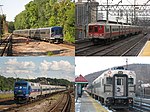
Hopewell Junction is a hamlet and census-designated place (CDP) in Dutchess County, New York, United States. The population was 1330 at the 2020 census. It is part of the Poughkeepsie–Newburgh–Middletown, NY Metropolitan Statistical Area as well as the larger New York–Newark–Bridgeport, NY-NJ-CT-PA Combined Statistical Area.

Metro-North Railroad, trading as MTA Metro-North Railroad, is a suburban commuter rail service operated by the Metropolitan Transportation Authority (MTA), a public authority of the U.S. state of New York. Metro-North serves the New York Metropolitan Area, running service between New York City and its northern suburbs in New York and Connecticut, including Port Jervis, Spring Valley, Poughkeepsie, Yonkers, New Rochelle, Mount Vernon, White Plains, Southeast and Wassaic in New York and Stamford, New Canaan, Danbury, Bridgeport, Waterbury, and New Haven in Connecticut. Service in Connecticut is operated under contract with the Connecticut Department of Transportation. Metro-North also provides local rail service within the New York City boroughs of Manhattan and the Bronx.
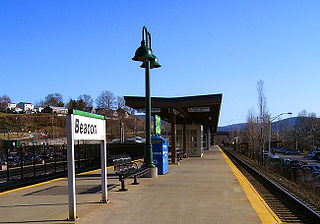
Beacon station is a commuter rail station on the Metro-North Railroad Hudson Line located in Beacon, New York. The station has three tracks, with one island platform and one side platform.

Dover Plains station is a commuter rail stop on the Metro-North Railroad's Harlem Line, located in Dover, New York.

Brewster station is a commuter rail stop on the Metro-North Railroad's Harlem Line, located in Brewster, New York.
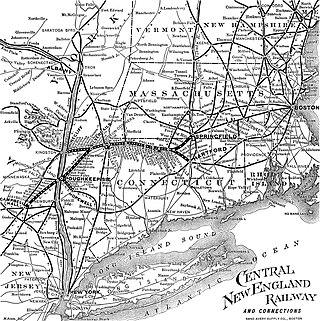
The Central New England Railway was a railroad from Hartford, Connecticut, and Springfield, Massachusetts, west across northern Connecticut and across the Hudson River on the Poughkeepsie Bridge to Maybrook, New York. It was part of the Poughkeepsie Bridge Route, an alliance between railroads for a passenger route from Washington to Boston, and was acquired by the New York, New Haven & Hartford Railroad in 1904. The New Haven ran the CNE as a separate company until finally merging it in 1927. The vast majority of the system was abandoned by the 1930s and 1940s. Surviving portions of the Central New England Railway are operated by the Central New England Railroad and the Housatonic Railroad.

The New York and New England Railroad (NY&NE) was a railroad connecting southern New York State with Hartford, Connecticut; Providence, Rhode Island; and Boston, Massachusetts. It operated under that name from 1873 to 1893. Prior to 1873 it was known as the Boston, Hartford and Erie Railroad, which had been formed from several smaller railroads that dated back to 1846. After a bankruptcy in 1893, the NY&NE was reorganized and briefly operated as the New England Railroad before being leased to the competing New York, New Haven and Hartford Railroad in 1898.
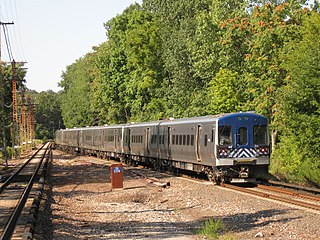
The Harlem Line is an 82-mile (132 km) commuter rail line owned and operated by the Metro-North Railroad in the U.S. state of New York. It runs north from New York City to Wassaic, in eastern Dutchess County. The lower 53 miles (85 km) from Grand Central Terminal to Southeast, in Putnam County, is electrified with a third rail and has at least two tracks. The section north of Southeast is a non-electrified single-track line served by diesel locomotives. Before the renaming of the line in 1983, it eventually became the Harlem Division of the New York Central Railroad. The diesel trains usually run as a shuttle on the northern end of the line, except for rush-hour express trains in the peak direction.

The Newburgh, Dutchess and Connecticut Railroad was a railroad in Dutchess County, New York, United States. Its line ran 58.9 miles (94.8 km) northeast from the Hudson River in Fishkill to the Connecticut state line near Millerton. The Dutchess and Columbia Railroad (D&C), was chartered in 1866 to link rural villages with the Hudson River Railroad and New York and Harlem Railroad. The under-construction line was leased by the Boston, Hartford and Erie Railroad (BH&E) in 1868. The first segment opened in July 1869, and it reached Pine Plains the following February.
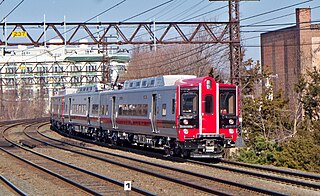
The New Haven Line is a 72.7 mi (117.0 km) commuter rail line operated by the Metro-North Railroad in the U.S. states of New York and Connecticut. Running from New Haven, Connecticut, to New York City, the New Haven Line joins the Harlem Line in Mount Vernon, New York, and continues south to Grand Central Terminal in Manhattan. The New Haven Line carries 125,000 passengers every weekday and 39 million passengers a year. The busiest intermediate station is Stamford, with 8.4 million passengers, or 21% of the line's ridership.
The New York and Putnam Railroad, nicknamed the Old Put, was a railroad line that operated between the Bronx and Brewster in New York State. It was in close proximity to the Hudson River Railroad and New York and Harlem Railroad. All three came under ownership of the New York Central system in 1894. The railroad was abandoned starting in 1958, and most of the former roadbed has been converted to rail trail use.

The Housatonic Railroad is a Class III railroad operating in southwestern New England and eastern New York. It was chartered in 1983 to operate a short section of ex-New York, New Haven and Hartford Railroad in northwestern Connecticut, and has since expanded north and south, as well as west into New York State.

The Danbury Branch is a diesel branch of the Metro-North Railroad's New Haven Line in the U.S. state of Connecticut, running from downtown Norwalk north to Danbury. It opened in 1852 as the Danbury and Norwalk Railroad. Until the early 1970s, passenger service continued north from Danbury to Canaan, Connecticut, and Pittsfield, Massachusetts. Metro-North took over operation of the line from Conrail in 1983, and the modern-day branch is mostly single-tracked.

The Danbury and Norwalk Railroad, chartered in 1835 as the Fairfield County Railroad, was an independent American railroad that operated between the cities of Danbury and Norwalk, Connecticut from 1852 until its absorption by the Housatonic Railroad in 1886. The right of way established by the D&N continues in operation and is now the Danbury Branch of the New Haven Line of the Metro-North Railroad.
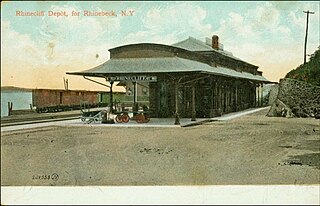
The Rhinebeck and Connecticut Railroad (R&C) was a railroad in Dutchess and Columbia counties in New York, United States. Its line ran 35 miles (56 km) east from the Hudson River at Rhinecliff to Boston Corners. It was chartered in 1870 to connect the Connecticut Western Railroad with the Hudson River to transport coal mined in Pennsylvania. Construction began in 1871, with the line opening in stages from 1873 to 1875. The railroad went bankrupt in 1881; it was purchased the next year by Connecticut Western successor Hartford and Connecticut Western Railroad (H&CW).

The Dutchess Rail Trail is a 13-mile (21 km) rail trail that stretches from the former Hopewell Junction train depot, north to the Poughkeepsie entrance of the Walkway over the Hudson. It's a shared use rail trail open for pedestrians and bicyclers. The Dutchess Rail Trail forms part of the Empire State Trail.
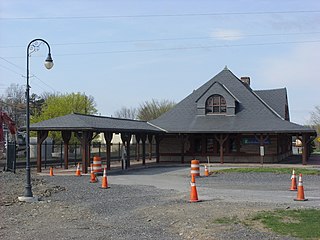
Union Station served the residents of Chatham, New York, from 1887 to 1972 as a passenger station and until 1976 as a freight station. It was the final stop for Harlem Line trains. It had originally served trains of the Boston and Albany Railroad, then the New York Central Railroad and the Rutland Railway. It served as a junction for service that radiated to Rensselaer, New York, to the northwest; Hudson, New York, to the southwest; Vermont, to the northeast, and Pittsfield, Massachusetts to the east and New York City, to the south.

The Housatonic Railroad was a railroad in the U.S. states of Connecticut and Massachusetts, chartered in 1836. Opened between Bridgeport, Connecticut, and New Milford, Connecticut, in 1840, it was completed to a connection with the Western Railroad in West Stockbridge, Massachusetts, in 1842. Branches were later built to Pittsfield, Massachusetts, Danbury, Connecticut, and Derby, Connecticut, the latter as part of the Housatonic Railroad's purchase of the New Haven and Derby Railroad in 1887.
The Maybrook Line was a line of the New York, New Haven and Hartford Railroad which connected with its Waterbury Branch in Derby, Connecticut, and its Maybrook Yard in Maybrook, New York, where it interchanged with other carriers. It was the main east-west freight route of the New Haven until its merger with the Penn Central in 1969.
















